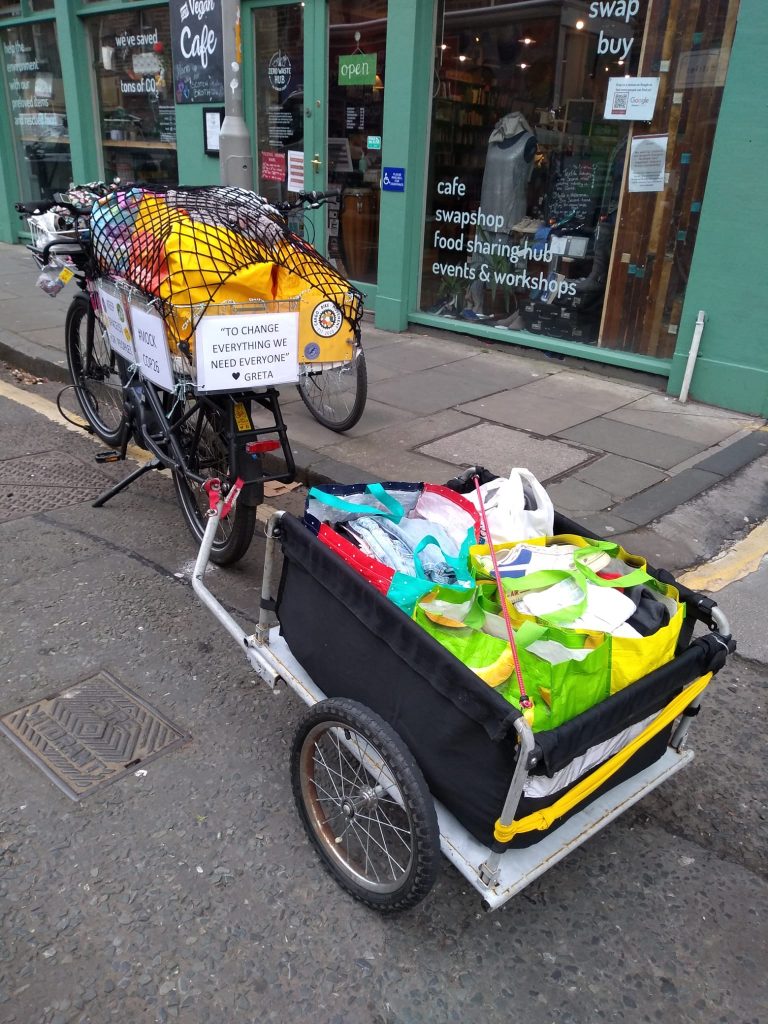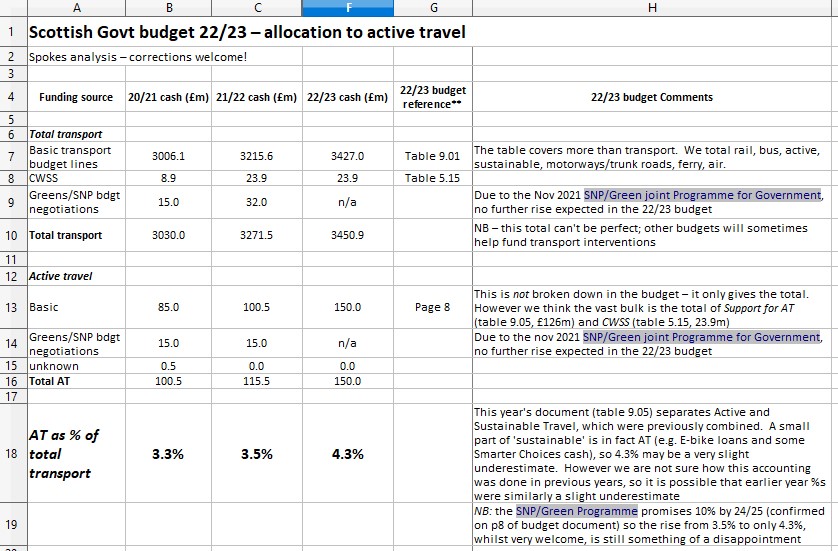The budget brings a welcome rise in active travel [AT] funding, up by £34.5m from 3.5% of the total transport budget to 4.3% … but it’s less than we expected given the SNP/Green promise of 10% by 24/25.
Active Travel cash in the 22/23 budget rises to £150m, up from £115.5m in 21/22.
Following the November 2021 SNP/Green agreement on a Programme for Government, the Greens will vote to support the budget, giving an overall majority. Thus the above figures are almost certainly final and we will see none of the haggling over the draft budget which occurred in previous years.
The following table shows our budget analysis, as far as we can go from the relatively skimpy information available so far. Corrections are welcome!
Under the SNP/Green Programme for Government, AT will receive 10% of the total transport budget (or a minimum of £320m) by the 24/25 budget, the final budget of the current government. This will be a truly momentous sum in the Scottish context – but it is necessary if we are seeking significant modal shift through providing widespread quality infrastructure of the type seen in the more advanced European countries.
Does the increase match up to promises and targets?
We had hoped, and perhaps expected, that the budgets between 22/23 and 24/25 would provide roughly equal ‘chunks’ towards the 10% budget share promise. This would have required a 22/23 increase of some £65m, almost twice the £34.5m that has in fact been allocated.
It may seem a little churlish to ‘complain’ about the increase, but our aim is to help the Scottish Government achieve its existing tough targets and maximise the effectiveness of its existing ambitious policies. We do not want another fiasco like the 2010 target to increase bike use to 10% of trips by 2020, where government actions, despite many warnings, consistently failed to meet the challenge which they had set themselves.
There are substantial reasons why the trajectory to the promised 10% budget share should not be ‘backloaded’ with a small rise at the outset and a huge rise in the final year.
- Planning and building AT infrastructure – including the necessary legal orders and overcoming nimby opposition – takes time. And, once infrastructure is in place, modal shift to use the new facilities only builds up over time.
- Backloading the cash postpones delivery and thus postpones modal shift. This was recognised as long ago as 2010 in the Scottish Government’s first ever report [RPP1 – Low Carbon Scotland] on meeting climate targets. Appendix table A2 [p145] proposed a 10-year AT infrastructure program of around £1200 of which roughly half would in fact be front-loaded into the first 3 years. Table A1 then shows how the carbon savings are predicted to gradually build up – over a period of years. (Sadly this proposal was quietly forgotten, despite many reminders from ourselves).
- The Scottish Government sees AT as an important tool in its commitment to a 20% reduction in car-km by 2030 but, if it is to achieve that, the infrastructure needs to start appearing in quantity soon. Furthermore, the Scottish Government seems to be hoping to achieve its targets largely by ‘carrots’ alone: we are very sceptical if that alone can succeed – but it certainly will not succeed if the carrots don’t appear in quantity in good time!
- Ensuring the skills, training and political leadership necessary for the growing AT cash to be fully used and to be effectively used is a major challenge. Transport Scotland, Council officers, transport consultancies and many politicians have for years been geared to a ‘car is king’ mentality. Whilst that has begun to change in government and in some Councils, such as Edinburgh and Glasgow, government must take the lead right now in ensuring widespread culture change and training right across Scotland. Spreading the increased cash evenly over several years would allow this process to be more effective than relatively small rises followed by a huge chunk at the end.
How will the cash be used?
The budget, as usual, gives little detail about how the AT cash will be used – that gradually emerges over the weeks and months.
However, we note that the CWSS (Cycling Walking Safer Streets) element, £23.9m, remains unchanged from last year. This is cash which goes to all Councils on a per-capita basis; they do not have to put in bids for it. It was increased very substantially last year by Cabinet Secretary Michael Matheson, from just £8m, with the specific mention that it could be used to make successful Spaces for People infrastructure permanent. Since that increase remains in place this is hopefully a sign that the government wishes that process to continue.
The bulk of the cash however, including the £34.5m rise, appears in the budget in a single sum of £126m called Support for Active Travel (table 9.05). A spreadsheet of ‘Level 4’ information explains that..
- £114m of this will go to capital investment, such as the Places for Everyone scheme run by Sustrans Scotland, where councils and others can bid for AT project cash, large or small
- £12m will be ‘current grant’ for active travel promotion and other Cycling Action Plan purposes.
No further details are given – probably many decisions on allocation of the cash are still to be taken.
The table below, the funding for Edinburgh City’s 5-year AT investment plan, shows the importance of the central government AT budget. Edinburgh contributes £20m from its own capital funds, and this attracts over £80m from the government transport budget, via Sustrans (including some back-payments), on top of the £12m CWSS amount direct from government.

Edinburgh Council 5-year AT Investment Plan, from 14.10.21 Transport Committee
What you can do
- Contact MSPs … At national level, as mentioned above, it is very unlikely that the draft budget can be changed before the final vote on it in the new year. However it will be important to keep reminding MSPs and other policy makers that they must do better in next year’s budget, or we will end up with just one huge dollop in 24/25, without having built up the capacity to use it effectively
- Contact councillors … For councils, there is very likely going to be significantly more cash available to bid into in the Places for Everyone scheme in 2022, and of course significantly more in the next couple of years after that. So ask your councillors to be ambitious! Every council will also automatically be receiving CWSS cash (explained above), which they do not need to bid for.
- Retweet our tweet of this article – thanks!

One of Edinburgh’s few so far, short, segregated bike lanes, York Place 
A Spokes-supported cargo-bike, pointing to the future 
The new Spokes Edinburgh Bike Map – now with the Spaces for People main road protected cycleroutes

